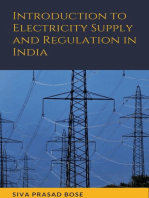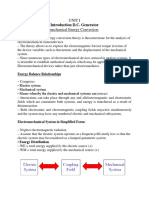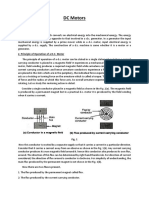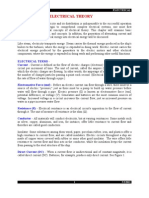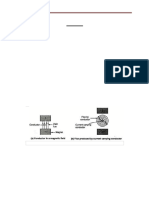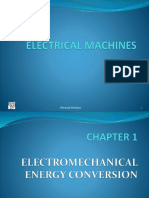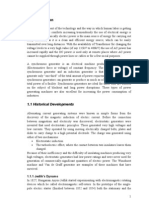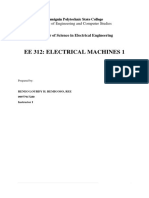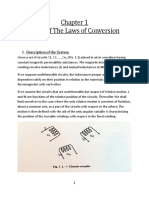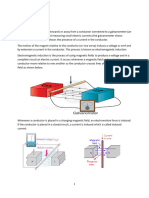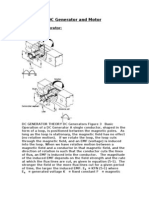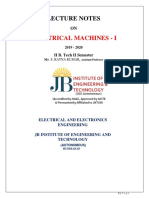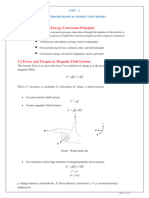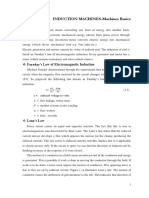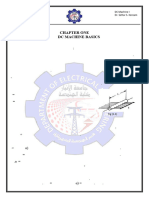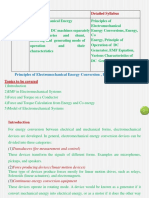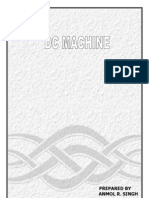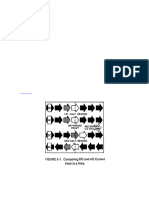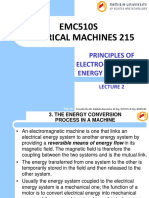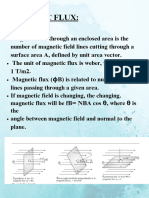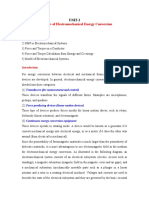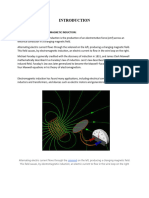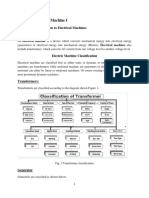2024 Ec
2024 Ec
Uploaded by
hathanhchinh_bsCopyright:
Available Formats
2024 Ec
2024 Ec
Uploaded by
hathanhchinh_bsOriginal Title
Copyright
Available Formats
Share this document
Did you find this document useful?
Is this content inappropriate?
Copyright:
Available Formats
2024 Ec
2024 Ec
Uploaded by
hathanhchinh_bsCopyright:
Available Formats
ENGNG 2024 Electrical Engineering
FUNDAMENTALS OF ELECTROMECHANICAL ENERGY CONVERSION
1.
PRELIMINARY CONSIDERATIONS
Electromechanical energy conversion is achievable in a number of ways. These possibilities rely on different fundamental laws of electrical engineering. As the only method that has importance on the large scale is electromechanical conversion achieved by means of electromagnetic converters, this section is fully devoted to the analysis of basic principles involved in electromagnetic electromechanical conversion. Electromechanical energy conversion is achieved by devices that are usually called electric machines. In principle, laws of electromagnetics can be used to design converters with the linear and with the rotary motion. Converters with linear motion are called linear electric machines, while those that rely on rotating motion are called rotating electric machines. Vast majority of existing machinery belong to the category of rotating electric machines. These include all the machines used to generate the electricity, as well as the most of the machines used in industry to perform some useful work while converting electric into mechanical energy. Linear machines are used relatively rare for somewhat specialised applications. It is for this reason that only rotating electric machines will be dealt with here. Prefix rotating will be omitted and the converters will be called simply electric machines, implying that devices under consideration are characterised with rotational movement. Operating principles of electric machines involve two basic laws of electromagnetism, namely the law of the electromagnetic induction (Faradays law) and the law of force creation in an electromagnetic field (Bio-Savarts law). Consider the situation shown in Fig. 1. A conductor is connected to an electric source and it carries current I. It is placed in the magnetic field of certain flux density B (which is of course a vector; hence the arrow above the symbol in Fig. 1). Interaction of the flux density and the conductor current leads to the creation of an electromagnetic force (1) Fe = Il B where l is the conductor length. This electromagnetic force will cause the movement of the conductor, which will start travelling at certain linear speed v to the left. The electromagnetic force will be balanced by another, mechanical force that acts in the opposite direction (to the right). The equilibrium will be established when the two forces are mutually equal and the conductor will then travel at a constant speed. Note that the magnitude of force in (1) will simply be Fe = IlB, since the angle between the conductor and the flux density is 90 degrees. Once when the conductor moves, according to the law of electromagnetic induction an electromotive force will be induced in the electric circuit, e = v B l (2) The magnitude of this emf is simply e =vBl, since the angle between the speed vector and flux density vector is 90 degrees, while the angle between the conductor length vector and the vector product is zero degrees. A process of electromechanical conversion is established in this way. The energy will be converted from electrical to mechanical and the process is called motoring. In order for the motoring to happen it is necessary to: i) establish flux density, using permanent magnets for example; ii) create an electric circuit, that is connected to a voltage source and is placed in the flux density. This will lead to establishment of the electromagnetic force, which causes linear movement of the conductor. This movement is counterbalanced by the applied mechanical
E Levi, 2002
ENGNG 2024 Electrical Engineering
force (not shown in Fig. 1) and the equilibrium is established when the conductor travels at a constant speed. Under this condition the electromagnetic force and the mechanical force are mutually equal, but act in the opposite directions. Consider next Fig. 2, where the same conductor is placed in the same flux density. However, the conductor is now not connected to the electric source; instead, the electric circuit is closed by using, say, an external resistance. The conductor is now dragged through the flux density using mechanical force at certain speed and this is the origin of the movement in this case. The sequence of events now reverses. An electromotive force, given with (2), is at first induced in the conductor. Since the circuit is closed, a current starts flowing. Interaction of the current and the flux density causes creation of the electromagnetic force. This force again acts in the opposite direction to the mechanical force and the equilibrium is established when the two forces are equal but act in the opposite direction. Note that in this case the source of motion is the supplied mechanical energy. The mechanical energy is now converted into electrical energy and the process is called generation.
B Fe Fm
B Fe
v I
v I
Fig. 1 Illustration of motoring.
Fig. 2 Illustration of generation.
It is important to note here that the process of electromechanical energy conversion is reversible. This means that either electric energy can be converted into mechanical energy, or mechanical energy can be converted into electric energy, by means of the same physical assembly. Note as well that both the expression for electromagnetic force acting on a conductor and the expression for induced electromotive force due to relative movement of conductor with respect to flux density, which are vectorial, reduce to very simple expressions due to the relative position of flux density vector, conductor and speed of motion. This is exactly the situation that is encountered in electric machines. Therefore equations (1) and (2), which contain scalar and vectorial multiplications, reduce to a very simple form of Fe = IlB and e = vBl. Nothing changes in principle when rotational movement is under consideration instead of the linear movement. Table I gives the analogy between the linear and the rotational movement. Creation of torque in the case of rotational movement is illustrated in Fig. 3.
Table I Analogy between linear and rotational movement.
Linear motion Rotational motion Speed Linear, v [m/s] Angular, [rad/s] Source of motion Force, [N] Torque, [Nm] Road travelled Linear, s [m] Angle, [rad] Power Fv T
Suppose once more that there is a certain flux density, in which a structure is placed. This structure can rotate and is of radius r. Assume that there are two conductors placed on the structure, 180 degrees apart, as shown in Fig. 3, and let these two conductors carry current in designated (mutually opposite) directions. An electromagnetic force, Fe = IlB, is created on each of the two conductors. However, one of these two forces acts to the left, while the other
E Levi, 2002
ENGNG 2024 Electrical Engineering
one acts to the right (due to opposite directions of the current flow in the two conductors). Now, a torque is created on each of the two conductors, that equals the product of the force and the radius. However, since forces act in opposite directions at opposite sides of the structure, the torques will both act in anticlockwise direction, initiating the rotation of the structure in anticlockwise direction. The total electromagnetic torque will in general be the sum of all the individual torques acting on individual conductors.
B Current in Fe
Fe
Current out
Fig. 3 Torque creation in the rotating structure.
Every electric machine consists of ferromagnetic iron cores and windings mounted on the iron cores, these elements being of essential importance for electromechanical conversion. An electric machine consists of a stationary element, called stator, and a rotating element (such as the one in Fig. 3) called rotor. The winding is placed in slots of the stationary stator and/or in slots of rotational rotor. The winding consists of an appropriate number of turns. A turn is composed of two conductors which are placed in such a way that the induced electromotive forces in them sum up. The current therefore flows in the opposite direction, as illustrated in Fig. 3. As already noted and explained, the operation of electric machines relies on Faraday's law of electromagnetic induction and on Bio-Savar's law of electromagnetic force (torque). One important point to note is that the induced emf will be described with (2) only if the current in the system is pure constant DC current. A more general expression for the induced emf says that, if the total flux through the electric circuit is changed, an electromotive force is induced, e = d dt = Li (3) e = L di dt i dL dt = L di dt i dL d (d dt )
di dL + i dt d The first term in this expression will exist only in circuits with AC currents and it is called transformer emf. The second term is what corresponds to (2) and it is the induced emf due to the movement of a conductor in certain flux density. It is called rotational emf. Note that, according to (3), a rotational emf will be induced only if the inductance of an electromagnetic structure is a function of the rotor position . This may sound awkward but will be clarified later on. In deriving (3) the use was made of the correlation between the angle travelled by the rotor and its speed of rotation, e = L
E Levi, 2002
ENGNG 2024 Electrical Engineering
= dt
(4)
that reduces for a constant speed of rotation to = t. Chain differentiation rule was applied as well. The total flux of the winding is called flux linkage and is denoted with in (3). It depends on the flux seen by each conductor and on the number of turns N. Flux linkage is = N. Electromotive force in an electric machine is induced either due to rotation of a winding in the flux density, or due to rotation of the flux density with respect to a stationary winding. Change of flux linkage can be caused either by mechanical motion or by change of current in time. This is reflected in (3) and will be elaborated in detail later on. Let us further clarify the two operating regimes of electric machines, generating and motoring. Generating is discussed first. Due to the action of the prime mover (which delivers mechanical energy to the machines shaft) rotational part of the machine is forced to rotate (Fig. 4). Consequently, the speed of rotation is constant (n = const.) and Te = TPM. Voltage at machine terminals and induced emf differ because of the voltage drop in the winding; for generating induced emf is greater than terminal voltage (in the sense of rms values in AC machines, i.e. in the sense of average values in DC machines). Note that in generation direction of the speed of rotation coincides with the direction of the mechanical (prime movers) torque, while the electromagnetic torque of the machine opposes motion. During motoring (Fig. 4) created electromagnetic torque, which is a consequence of electric energy delivered to the machine, acts as the source of motion, i.e. it causes the rotor rotation. In this case the direction of speed and the electromagnetic torque coincide, while the mechanical torque (that is now load torque) acts against the direction of rotation. Once more the speed of rotation is constant (n = const.) and Te = TL. During motoring induced emf has the opposite polarity since it balances the applied voltage. It is therefore usually called counter-electromotive force. The terminal voltage is greater than the counter-emf in motoring.
n TPM n Te
Te
TL
Fig. 4 Torque and speed directions in generation (left) and motoring (right).
In what follows a generalised electromechanical converter is discussed at first. The analysis is valid for any type of electric machine; the only constraint is that there is only one degree of freedom for mechanical motion (i.e. rotor can rotate along one axis only). 2. GENERAL MODEL OF AN ELECTRIC MACHINE
2.1
Losses and efficiency
Efficiency of an electric machine is defined in the same way as for any other device, as ratio of the output to input power
E Levi, 2002
ENGNG 2024 Electrical Engineering
Pout Ploss =1 <1 (5) Pout + Ploss Pout + Ploss where the difference between the input and the output power is the loss in the machine, that consists of three components: winding loss (or copper loss) that is caused by the current flow in windings of the machine (in general, it appears at both stator and rotor), iron (or core) loss that appears in the ferromagnetic structure of the machine that is exposed to AC flux, and mechanical loss that takes place due to friction in bearings and rotation of the rotor in the air: Ploss = Pin Pout = PCu + PFe + Ploss mech (6) 2 Copper losses are of standard RI form and total winding loss is given with the summation of losses for all individual windings. Iron or core loss depends on the flux density and frequency and comprises hysteresis and eddy-current losses, 2 PFe = mFe (f + f 2 )Bm (7) It is, according to (7), proportional to the mass of the ferromagnetic material. Mechanical loss can be taken as proportional to the speed of rotation squared, Ploss mech = k 2 (8) Since mechanical power is a product of torque and speed, this means that the mechanical loss torque is taken as proportional to the speed of rotation. One important point to note is that the nature of the input and output power depends on the role of the machine. In motoring the input power is electrical, while the output power is mechanical. In generation it is the other way round, the input power is mechanical while the output power is electrical (in generation, there may be some windings that take electrical power as well, while some other windings generate electrical power). It has to be remembered that the rated power of the machine (power for which the machine has been designed), which is always given on the nameplate of the machine, is the output power. Hence, in generation the known rated power (always identified further on with an index n) is the output electrical power, while in motoring it is the output mechanical power.
= Pout Pin =
2.2
Power flow in an electric machine
Since the role of the input and the output power is dependent on the function that the machine performs, the two cases are treated separately. In what follows lower case symbols are used for all the quantities, meaning that instantaneous time-domain variables are under consideration. The idea behind the subsequent development is to develop a general mathematical model that is valid for any rotating electric machine. It is for this reason that the number of windings is not specified. Instead, it is taken as being equal to n, where this is an arbitrary number. The electric machine is for the time being a black box. There are two doors that enable access to the machine, electrical door and mechanical door. The power can be either delivered to the machine, or taken away from the machine, through these two doors. Electromechanical conversion takes place inside the box and the converted power is pc. Fig. 5 illustrates power flows inside an electric machine for motoring and generating. Apart from these two doors there are two windows that are unwanted outputs only. These windows are outputs for winding losses and mechanical losses, which are inevitably created within a machine, and which represent lost power. Note that the iron (or core) loss is omitted from this representation. The reason is that it is of electromagnetic nature and it does not take place in the windings. The existence of the iron loss can be accounted for at a later stage, in an approximate manner, as it is done in transformer theory. Both doors can be either inputs or outputs (depending on whether the machine operates as a motor or as a generator), while windows are outputs only. Normally, one door will be the input while the other door will be the output, although in generation some windings make consume electrical energy, while
E Levi, 2002
ENGNG 2024 Electrical Engineering
other windings are generating it (as shown in Fig. 5). The role of doors is thus reversible, as the machine can operate both as a generator and as a motor.
Copper losses in windings
Mechanical loss
Electrical input power
Converted power
Mechanical output power
Electromagnetic energy storage
Mechanical energy storage
Copper losses in windings Small electrical input power
Mechanical loss
Electrical output power
Converted power
Mechanical input power
Electromagnetic energy storage
Mechanical energy storage
Fig. 5 Power flow in an electric machine for motoring and generation, respectively.
As can be seen from Fig. 5, apart from input and output power and losses, there are two internal storages of energy inside the machine. The first one is the stored electromagnetic energy, while the second one is the stored mechanical energy. Stored mechanical energy is the energy stored in rotating masses (kinetic energy) and it is in every aspect analogous to the 1 energy stored under linear movement (which is Wmech = mv 2 , where m is the mass of the 2 body). Rotating bodies are characterised with so-called inertia (that is function of the mass and dimensions) J [kgm2], while instead of the linear velocity one uses angular velocity. Hence 1 Wm = J 2 (9) 2 Stored energy in the electromagnetic system is function of the inductances and the currents of the windings (or flux linkages and currents). For example, in the case of a single winding
E Levi, 2002
ENGNG 2024 Electrical Engineering
1 2 1 Li = i 2 2 If the machine has two windings, then the stored energy is 1 1 2 1 We = L1i12 + L2i2 + L12i1i2 = ( 1i1 + 2i2 ) 2 2 2 1 = L1i1 + L12i2 We =
(10a)
(10b)
2 = L2i2 + L12i1 Taking index e for electrical power and index m for mechanical power in Fig. 5, one can write the following power balance equations: Motoring: dWe pe = pCu + + pc dt (11) dWm + pm pc = ploss mech + dt Generation: dWm pm = ploss mech + + pc dt (12) dWe + pe1 pe 2 pc = pCu + dt Note that storages are energies, as defined in (9)-(10). Powers are time derivatives of energies and this is taken into account in formulation of (11)-(12). In generation some windings make take the power (pe2), while other winding actually generate the power (pe1). Equations (11)-(12) enable formulation of the converted power that is defined as pc = te m (13) in terms of other known powers and derivation of the equation for motion of rotating masses in terms of known parameters and inputs of the machine. This is a tedious procedure for the generalised n-winding converter and most of the derivations will be therefore omitted. Only the starting equations and the final equations are presented in the next sub-section. It is to be noted that all the powers, as well as all the other variables (currents, flux linkages) were denoted with lower-case letters in this section. These are instantaneous time domain quantities, and the same approach is used in the following sub-section. This enables creation of a general mathematical model, in terms of time-domain instantaneous quantities, that is valid for all possible existing types of electric machines with rotational movement.
2.3 Mathematical model
Each of the n windings of the machine is a piece of wire. Hence each winding can be characterised with its resistance and inductance. In addition, there are mutual inductances between any two windings. An induced emf appears in general in each winding. Hence the voltage equilibrium equation for one particular winding can be written as vi = Ri ii e = Riii + d i dt (14) i = Li ii + Li1i1 + L12i2 + ........... + Linin There is one flux linkage equation and one voltage equation for each of the n windings. It is convenient to use further on matrix notation to express these and other equations, since matrix notation will enable substitution of n equations with a single matrix equation. Hence for all the n windings one has (matrices are underlined):
E Levi, 2002
ENGNG 2024 Electrical Engineering
v = Ri +
d dt
(15)
R2 .. .. Rn 1 Rn
L21 L31 .. .. Ln1
L2 L32 .. .. Ln 2
L23 .. .. L2 n L33 .. .. .. .. L3n .. .. .. .. .. ..
R=
L=
Ln3 .. .. Lnn
v2 v3 .. .. vn
i2 i3 .. ..
v=
i=
in
Note that in any electrical machine Lij = Lji. Input electrical power in motoring is T pe = v1i1 + v2i2 + .......... + vnin = i v (17) Note that current matrix in (17) has to be transposed to satisfy the rules of matrix multiplication. In generation the output power is T pe = v1i1 + v2i2 + .......... + vk ik vk +1ik +1 .... vnin = i v (18) where winding 1k generate electricity, while windings k+1n consume electric energy. Current vector in (18) has positive currents for the windings that generate and negative currents for the windings that consume electric power. Winding losses can be expressed as T 2 2 pCu = R1i12 + R2i2 + ....... + Rnin = i R i (19) Stored electromagnetic energy is 1 2 1 2 1 2 We = L1i1 + L2i2 + .... + Lnin + L12i1i2 + L13i1i3 + ..... + L1ni1in + L23i2i3 + .... + L( n 1) nin 1in 2 2 2 (20) 1 T We = i Li 2 Current sign in voltage equation (15) is such that the current is positive when it flows into the winding. Hence in generation all the windings that generate will have negative currents since the current flow will be in the opposite direction from assumed positive current flow. Mechanical power and mechanical loss are governed with pm = tm
ploss mech = tloss mech tloss mech = k
and the correlation between speed of rotation and the angle travelled is
E Levi, 2002
v1
i1
1 2 = 3 .. .. n
= Li where R1
L1
L12
L13
.. .. L1n
(16a)
(16b)
(21)
ENGNG 2024 Electrical Engineering
= dt
= d dt
(22)
2 n . Angle is the 60 mechanical angle measured with respect to certain stationary defined axis in the machines cross-section. Mechanical torque in (21) can be the load torque (in motoring) or the prime mover torque (in generation). Stored mechanical energy remains to be given with 1 Wm = J 2 (23) 2 What remains to be done is to substitute all the powers and derivatives of stored energies into the power balance equations (11)-(12). This enables, first of all, calculation of the converted power and the electromagnetic torque. Regardless of which of the two regimes is considered, the converted power is found to be 1 T dL pc = i i (24) 2 dt Since according to (13) converted power is pc = te and since one can write using chain
Angular speed of rotation is related to the speed n in [rpm] through =
differentiation rule that d L / dt = (d L d )(d dt ) = (d L d ) , one finds the electromagnetic torque in the form 1 T dL p te = c = i i (25) 2 d Electromagnetic torque is positive for the motoring, while it has negative value in generation (as it opposes motion). From the second of (11) or the first of (12) one finds the equation of motion of the rotor in the form d te TL = J + k motoring dt (26a) d TPM te = J + k generation dt On the left-hand one has the difference between the driving torque (electromagnetic torque in motoring, prime mover torque in generation) and the opposing torque (load torque in motoring and electromagnetic torque in generation). On the right-hand side the first term is the acceleration/deceleration torque (that exists only during transients and is zero in steadystate) and the second term is the torque that describes mechanical losses. This particular torque can be always taken as part of the load (or prime mover) torque since it is mechanical in nature. One then arrives at the equation of mechanical motion in the frequently used form d te TL = J motoring dt (26b) d TPM te = J generation dt which shows that in any steady state (at constant speed) te TL = 0 motoring (27) TPM te = 0 generation The meaning of (27) is simple. It is the basic law of action and reaction. In any steady state the two torques are of the same absolute value but act in the opposite direction. The equations presented in this sub-section fully describe any rotational electrical machine, in terms of the instantaneous time-domain variables. The full mathematical model is summarised in the following sub-section.
E Levi, 2002
ENGNG 2024 Electrical Engineering
2.4
Summary of the mathematical model
Any rotating electric machine, regardless of the actual structure of the stator and rotor and regardless of the number of windings, is completely described with the following set of equations: d v = Ri + dt = Li
te + tm = J tm =
d + k dt
TL , te > 0 TPM te < 0
motoring generation
(28)
1 T dL te = i i 2 d = d dt
where J and k are parameters of the machine and
R1 R2 .. .. Rn 1 Rn i2 i3 .. ..
L1 L21 L31 .. .. Ln1
L12 L2 L32 .. .. Ln 2
L13 L33 .. ..
.. .. L1n .. .. L3n .. .. .. .. .. ..
R=
v2 v3 .. .. vn
v=
i=
in
Equations (28)-(29) constitute the mathematical model of a generalised n-winding electromechanical energy converter. Note once more that all the variables (voltages, currents, flux linkages, electromagnetic torque, speed of rotation) are instantaneous time-domain quantities. Note as well that voltage equation is valid for current flowing into the winding. Hence in generation some of the currents will be negative since they will be flowing out of the machine. 2.5 Existence of converted power and electromagnetic torque and average torque
Equation (25) shows that power will be converted if and only if the machine rotates. This means that at zero speed converted power is always zero. Further, one can see that electromagnetic torque can exist at zero speed (a machine will always start from standstill and the torque at zero speed is called starting torque). In order for an electromagnetic torque to exist it is necessary that at least some windings carry current and that at least some inductances of the machine are functions of the rotor angular position. Note that unless this
E Levi, 2002
L23 .. .. L2 n
L=
Ln3 .. .. Lnn
v1
i1
1 2 = 3 .. .. n
(29)
10
ENGNG 2024 Electrical Engineering
condition is satisfied, torque will be zero. The issue of dependence of machines inductances on angular position of the rotor will be discussed later. Although an electromagnetic torque will exist if appropriate currents flow in the machine and there are inductances that depend on the rotor position, this is still not sufficient to realise useful electromechanical energy conversion. Assume that the torque of a hypothetical electric machine varies as a sine function of time, with the period equal to the period of rotation. The instantaneous torque does exist. But, it is positive in the first half-cycle and negative in the second half-cycle. The average torque is zero and hence the average converted power will be zero even if the machine runs at a constant speed. The machine will do motoring in the first half-cycle and generating in the second half-cycle, with a net zero converted power over one cycle. Thus it follows that, if useful electromechanical conversion is to take place, average torque of the machine must differ from zero. Average electromagnetic torque Te can only exist if the certain correlation between stator current (voltage) frequency, rotor current (voltage) frequency and the frequency of rotation is satisfied. It can be shown that Te will be of nonzero value if and only if = s r (30) where indices s and r identify stator and rotor angular frequency. Note that DC case is encompassed by (30). Note as well that, according to (30), it is not possible to realise useful electromechanical energy conversion if both stator and rotor windings are supplied with DC currents. In such a case an average torque can only exist at zero speed. But converted power equals zero at zero speed. On the basis of (30) is it is now possible to classify the most commonly used electric machines into three categories: 1. Synchronous machines: rotor frequency is zero. Hence frequency of rotation equals stator frequency. 2. Induction machines: both stator and rotor windings carry AC currents. Rotor speed is related with the two angular frequencies as = s r . 3. DC machines: stator frequency is zero. Hence frequency of rotation must equal frequency of rotor winding currents. Note that even when (30) is satisfied, this still does not mean that the electromagnetic torque is constant. However, if the machines torque varies in time, then it follows from the equation of the mechanical motion that the speed will constantly vary although mechanical torque might be perfectly constant. It is therefore necessary to provide such arrangements in electrical machines that not only (30) is satisfied but in addition te = Te (31) This implies that the instantaneous torque value equals the average torque. In other words, torque is just a constant time-independent quantity. The means of achieving (31) in AC machines (induction and synchronous) will be discussed shortly. Chapter on DC machines will explain how (31) is achieved in that particular case. 2.6 Fundamental and reluctance torque component
Consider as an example a rotating electric machine with one winding on stator and one winding on rotor. General mathematical model (28) d v = Ri + dt = Li
= d dt
(28)
E Levi, 2002
11
ENGNG 2024 Electrical Engineering
1 T dL te = i i 2 d TL , te > 0 motoring d (28) te + tm = J + k tm = TPM te < 0 generation dt remains to be valid in the same form. However, (29) reduces to vs is Rs Ls Lsr (32) i= = s R= L= v= vr ir r Rr Lrs Lr and the electromagnetic torque expression reduces to 1 dL 1 dL dL (33) te = is2 s + ir2 r + is ir sr 2 d 2 d d The first two components of the torque expression will have non-zero values only if the winding self-inductance is a function of the rotor position. The third torque component is the one due to the interaction of the stator and rotor winding and this component will exist in all machines that do have windings on stator and rotor. The component of the torque due to interaction of the stator and rotor winding is called fundamental torque component. The torque component that exists only if self-inductances of the windings are functions of the rotor position is called reluctance torque component. In general both torque components will contribute to the average torque so that Te = Tereluc tan ce + Te fundamental (34) Mutual inductance between a stator and a rotor winding is always a function of the rotor position. However, self-inductances are in many cases constants, so that the reluctance torque component will rarely exist. Fig. 6 illustrates two commonly met cross-sections of AC machines. The air-gap is white, while the rotor and stator body are grey. The first crosssection is characterised with cylindrical stator and rotor. The air-gap is therefore uniform. Recall that an inductance is inversely proportional to the magnetic reluctance. Magnetic reluctance comprises mostly of the air-gap reluctance. Since air-gap is uniform, the magnetic reluctance seen by both stator and rotor winding is constant. Self-inductances of the stator and rotor winding are in this configuration constant and they do not depend of the rotor position. The reluctance torque component is therefore zero and torque consists only of fundamental torque component. This cross-section corresponds to all induction machines, numerous synchronous machines (so-called turbo-machines and permanent magnet synchronous machines with surface mounted magnets) and modern DC machines.
Fig. 6 Two frequently met cross-sections of AC machines.
The other cross section in Fig. 6 is characterised with cylindrical stator and noncylindrical rotor. The rotor is of so-called salient pole structure. Assume that there is a winding on both stator and rotor. From the point of view of rotor the air-gap appears as
E Levi, 2002
12
ENGNG 2024 Electrical Engineering
constant so that rotor self-inductance is constant. However, stator self-inductance is a function of the rotor position, since the magnetic reluctance seen by the stator winding depends on where exactly rotor is. This particular cross-section is met in certain types of synchronous machinery (hydro-generators and synchronous reluctance motors). In this case the torque developed by the machine contains both the fundamental and the reluctance torque component. Functional dependence of a self-inductance on rotor position is beyond the scope of interest here. However, it is necessary to explain how the mutual inductance between the stator and the rotor winding depends on rotor position. Consider Fig. 7, where magnetic axes of the two windings are identified with symbols s and r. Magnetic axis of a winding is the axis along which a particular winding produces flux. Stator magnetic axis is obviously stationary, while rotor magnetic axis rotates with rotor. Let the maximum value of the mutual inductance between the two winding be M. Flux linkage of the stator and the rotor winding can be expressed as s = Ls is + Lsr ir (35) r = Lr ir + Lsr is For the sake of explanation, let us assume that rotor current is constant DC and let us investigate the contribution of this rotor current to the flux linkage in stator winding. The maximum value of the contribution of the rotor current to the flux linkage in stator winding, MIr, is shown along the magnetic axis of the rotor winding. Its projection on stator winding magnetic axis is LsrIr. Table II lists values of the contribution for various rotor positions. When the two axes are aligned (zero angle) the contribution is of maximum value. When the two axes are perpendicular, the contribution is zero. When the two axes are aligned but 180 degrees apart, contribution is of negative maximum value. The function that describes such behaviour is a cosine function. Hence the mutual inductance between the stator and the rotor winding can be written as
r MIr s LsrIr
Fig. 7 Magnetic axes of stator and rotor windings. Table II Contribution of rotor current to the stator flux linkage
Angle [] Lsr Ir 0 MIr 90 0 180 MIr 270 0 360 MIr
Lsr = M cos (36) The mutual inductance between a stationary and a rotating winding is therefore always a function of the rotor position. Simple sine or cosine functional dependence suffices for
E Levi, 2002
13
ENGNG 2024 Electrical Engineering
machines with uniform air-gap. If the machine is with salient poles on rotor, the expression for the mutual inductance becomes more complicated. As the next step, let us consider the induced emfs in the two windings of the machine in Fig. 7. By definition es = d s dt (37) er = d r dt Substitution of (35) into (37) yields to di di dL dL es = Ls s + Lsr r + is s + ir sr dt dt dt dt
es = Ls es = Ls
dis di dL dL d + Lsr r + is s + ir sr dt dt d d dt
dL dL dis di + Lsr r + is s + ir sr dt dt d d and in the same way for rotor
dir di dL dL + Lsr s + ir r + is sr dt dt d d The first term is the transformer induced emf, while the second term is the rotational emf. Note that in the case of Fig. 7, when both stator and rotor self-inductance are constant, (38) reduces to di di dL es = Ls s + Lsr r + ir sr dt dt d (39a) dir dis dLsr er = Lr + Lsr + is dt dt d Assuming further that rotor current is constant (this corresponds to a synchronous machine) further simplifies this expression to er = Lr
es = Ls
dis dL + ir sr dt d
Example 1: A two winding system has the following inductances: stator winding self inductance = 0.8 H, rotor winding self-inductance = 0.2 H and mutual inductance between the stator winding and the rotor winding = 0.4 cos [H]. The rotor revolves at constant angular velocity of 40 rad/s and the initial value of the mechanical co-ordinate at zero time instant equals zero. Determine the instantaneous value of induced electromotive force in open-circuited rotor winding if the current that flows through the stator winding is equal to 10cos(100t) A.
Solution: In this example rotor current and its derivative are zero since the rotor winding is open circuited. Moreover, stator and rotor self-inductances are constant. Hence the induced emf follows from (39b) as di dL e r = Lsr s + i s sr dt d Derivatives of the stator current and the mutual inductance are
E Levi, 2002
(38)
er = Lsr
dis dL + is sr dt d
(39b)
14
ENGNG 2024 Electrical Engineering
dis dt = 1000 sin 100t dLsr d = 0.4 sin
= dt = t = t
Substitution into the expression for the induced emf yields e r = 400 sin 100t cos 40t + 160 sin 40t cos 100t
e r = A sin cos + B cos sin N = 0.5( A + B ) e r = N sin( + ) + M sin( ) M = 0.5( A B ) e r = 280 sin 140t + 120 sin 60t
Example 2: A two-winding system has stator inductance of 0.1 H, rotor inductance of 0.04 H and mutual inductance of 0.05 cos [H]. a) Rotor rotates at 200 rad/s and stator current is known to be 10sin200t. Find the induced emf in rotor winding if it is open-circuited. The initial value of mechanical coordinate at zero time is zero. b) Current 10sin200t flows through both windings, which are connected in series. Find the speeds at which average torque will exist; find the average torque values and determine the values of the load angle which yield maximum values of the average torque.
Solution: a) Rotor current and its derivative are again zero. Hence once more di dL er = Lsr s + is sr dt d dis dt = 2000 cos 200t
dLsr d = 0.05 sin
= dt = t = t
e r = 100 cos 200t cos 200t 100 sin 200t sin 200t e r = 100 cos 400t
r = 400 [rad/s]
E r = 100 / 2 = 70.7 V b) Condition of average torque existence yields speeds at which the average torque will have non-zero values: = ( s r ) s = r = 200[rad / s]
0 [rad/s] 400 [rad/s] Note that both self-inductances are constant. Hence the torque contains only the fundamental torque component. Instantaneous torque is t e = is ir dLsr d = i 2 dLsr d
t e = 5 sin 2 200t sin (t ) = 2.5(1 cos 400t ) sin(t ) For the speed of zero [rad/s]: 1 Te = t e dt = 2.5 sin( ) = 2.5 sin [Nm] T Te max = 2.5 [Nm]
0 T
t e = (10 sin 200t )2 [ 0.05 sin (t )]
for = / 2
E Levi, 2002
15
ENGNG 2024 Electrical Engineering
For the speed of 400 [rad/s]:
Te =
1 t e dt T
t e = 2.5(1 cos 400t ) sin(400t ) t e = -2.5sin(400t - ) + 2.5cos400tsin(400t - ) t e = -2.5sin(400t - ) + 1.25sin(800t - ) - 1.25sin Te = -1.25sin [Nm] Te max = 1.25 [Nm] for = / 2 In this example both stator and rotor winding are supplied with single-phase currents. As the result shows, the average torque will exist at 400 [rad/s] speed of rotation. However, apart from the average torque, there will exist two more time varying components. This is true for any single-phase AC machine. It is not possible to realize conversion with constant time independent torque (i.e. it is not possible to achieve equality of the average and instantaneous torque values). It is for this reason that vast majority of AC machines in use nowadays are three-phase. It will be shown in the next section how utilization of a three-phase machine instead of a single-phase machine enables achievement of a constant time independent torque. Note as well that the angle , taken initially as the initial value of the mechanical co-ordinate, is actually much more than that. It is called load angle and its value depends on the loading of the machine. In this example machines average torque can be anything between zero and 1.25 [Nm] at 400 [rad/s]. How much it will be depends on the load torque. The load angle value will adjust itself in such a way that the motor torque and the load torque are mutually equal at the given speed of rotation.
Example 3: An electromechanical converter has a three winding structure, with two windings on stator and one winding on rotor. The two stator windings are displaced in space by 90 degrees. The winding self-inductances and mutual inductances are equal to:
Ls1 = 1 H Ls1r = 0.9 cos Ls1s 2 = 0 Ls 2 = 1 H Lr = 0.95 H Ls 2 r = 0.9 sin where = t
Rotor winding current is constant DC, of 10 A. Stator windings are fed with two-phase system of currents, such that
i s1 = 10 cos s t i s 2 = 10 sin s t
a) Sketch a cross-sectional view of the machine and identify the type of the machine. b) Develop the expression for the instantaneous and average torque produced by the machine under the assumption that the condition of average torque existence is satisfied. Calculate the average torque for load angle equal to 30 degrees and explain its nature. c) Sketch the dependence of average torque on load angle , identify motoring and generating part and define the region of stable operation.
Solution: In this example a so-called two-phase machine is considered. The example will show that with the specific two-phase winding structure on stator it is possible to realize electromechanical energy conversion with the time independent constant torque developed by the machine. Two-phase structure is realized by displacing in space two stator windings by 90 degrees and by feeding the two-phase winding with currents having phase displacement of 90 degrees. This example serves as an introduction into the explanation of why three-phase machines are used nowadays and how time independent torque is obtained, elaborated in the next section. a) Rotor frequency is zero. According to the condition of average torque existence, stator angular frequency must in this case equal angular frequency of rotation. The machine is therefore a synchronous machine with cylindrical stator and rotor structure. The cross section is shown in figure.
E Levi, 2002
16
ENGNG 2024 Electrical Engineering
S2 axis S1 r r S1 axis S2
b) Self-inductances of all the three windings are constants. Mutual inductance between two stator windings is zero. The instantaneous torque therefore contains only fundamental torque components and is given with t e = is1ir dLs1r d + is 2 ir dLs 2 r d
dLs1r d = 0.9 sin t e = I r [10 cos s t ( 0.9 sin ) + 10 sin s t 0.9 cos ] t e = 90 sin( s t t + ) dLs 2 r d = 0.9 cos
t e = 90[sin s t cos(t ) cos s t sin(t )]
s = t e Te = 90 sin Instantaneous torque is therefore time independent and equal to its average value. For the load angle of 30 degrees the average torque is 45 [Nm]. c) Average torque is a sine function of the load angle. Positive values correspond to motoring, while negative values describe generation. The machine can operate stably in the load angle region from -/2 to /2. The region from -/2 to zero is the generating region. The region from zero to /2 is the motoring region. Stable operation is not possible outside these regions.
3.
ROTATING FIELD IN THREE-PHASE MACHINES
Consider the stator winding of a three-phase AC machine. The winding is placed in slots with 120 degrees spatial displacement between any two respective phases. The winding is supplied with a system of three-phase currents, such that there is a phase displacement of 120 degrees between any two respective stator phases. Let the three phase currents be given with: ia = I m cos t ib = I m cos (t 2 / 3) ic = I m cos (t 4 / 3) (40) Current flow in each of the three phases causes an appropriate magneto-motive force (m.m.f.), that acts along the magnetic axis of the given phase. The situation is illustrated in Fig. 8, where individual phase m.m.f.s are given with (N is the number of turns per phase):
Fa = NI m cost Fb = NI m cos(t 2 / 3) Fc = NI m cos(t 4 / 3)
(41)
One observes that in terms of spatial dependence, all the three individual phase magnetomotive forces are stationary and they act along the defined magnetic axis of the winding. From (41) one notices that each of the three m.m.f.s is varying in time. The values of the
E Levi, 2002
17
ENGNG 2024 Electrical Engineering
three phase m.m.f.s in the given instant of time correspond to those met in any three phase system.
a c b Fa Fb Fc
b c a
Fig. 8 - Individual phase m.m.f.s of a three-phase winding. The resultant magneto-motive force that stems from the three phase system of currents flowing through spatially displaced windings is the sum of the individual contributions of the three phases. The summation is done in the cross-section of the machine, and it is necessary to observe the spatial displacement between the three m.m.f.s. One may regard the cross-section of the machine as a Cartesian co-ordinate system in which phase a magnetic axis corresponds to x-axis, while y-axis is perpendicular to it. For the purposes of calculation this co-ordinate system may be treated as a complex plane, with x-axis corresponding to the real axis, and yaxis corresponding to the imaginary axis. In terms of the complex plane, spatial displacement of the m.m.f. by 120 degrees corresponds to the so-called vector rotator, a = exp( j 2 / 3) . Hence the resultant magneto-motive force can be written as
Fres = Fa + aFb + a Fc
2
Fres = NI m ( cost + a cos( t 2 / 3) + a cos( t 4 / 3) )
2
a=e
2 3
, a =e
2
4 3
(42)
The expression for the resultant magneto-motive force is most easily found if one recalls the well-known correlation cos = 0.5( exp( j ) + exp( j )) . Hence
Fres = NI Fres = NI m
(e 2
1 1
jt
+e
jt
+ ae
j ( t 2 / 3)
+ ae
j ( t 2 / 3)
+ a 2e
jt
j ( t 4 / 3)
+ a 2e
j ( t 4 / 3)
)=
(e + e 2
j t
jt
+ aa * e
jt
+ aae
jt
+ a 2 a 2*e
+ a 2 a 2e
jt
)
(43)
1+ a + a 2 = 0 a* = a2 Fres = NI m Fres = NI m Fres = 3 2 1 2 1 a 2* = a a3 = 1 a + aa 2 ) + e
jt
a4 = a
( e (1 + a
j t j t jt
(1+ a 2 + a) ) =
( e ( 3) + e 2
jt
( 0)
NI me
Symbol * in (43) stands for complex conjugate. The result obtained in (5) is an important one. The equation
E Levi, 2002
18
ENGNG 2024 Electrical Engineering
Fres =
3 2
NI m e
jt
(44)
describes a circular trajectory in the complex plane. This means that the resulting magnetomotive force, produced by three stationary, time-varying m.m.f.s (often called pulsating m.m.f.s) is a time-independent and rotating magneto-motive force. Thus it follows that the three-phase system creates a rotating field (called also Teslas field) in the machine. Figure 9 illustrates the rotating field in different instants of time. The speed at which the rotating field travels equals the angular frequency of the stator three-phase supply.
Im t=90
t=135
Fres
t=45
t=0
Re (a) 1.5NIm
Fig. 9 - Resultant field in the three-phase machine for sinusoidal supply conditions. When the machine is synchronous, rotor winding carries DC excitation current and a field is produced by this current. This field is stationary with respect to rotor. Since the rotor rotates at synchronous speed, then, looking in from stationary stator, this rotor field rotates at synchronous speed. This is always the case in any multi-phase AC machine: regardless of whether the rotor rotates synchronously or asynchronously, all the fields in the machine rotate at synchronous speed. Since the resulting m.m.f. is responsible for the resulting flux density and ultimately resulting flux, this means that apart from the rotating m.m.f., there is a rotating flux density wave and a rotating flux in the machine as well. The term rotating field in general denotes any of the three.
Example 4: Consider a three-phase machine with cylindrical cross section of stator and rotor. Rotor carries a single winding, supplied with DC current. Mutual inductances between stator windings and rotor winding and three phase stator currents are given with:
Lar = M cos ia = I m cos s t Lbr = M cos( 2 / 3) ib = I m cos( s t 2 / 3) Lcr = M cos( 4 / 3) ic = I m cos( s t 4 / 3)
Derive the expression for the instantaneous and the average torque.
Solution: The instantaneous torque will once more be equal to the average torque, since the stator carries a threephase winding. All the self-inductances are constant, as are the mutual inductances within the stator winding. Hence the torque is:
E Levi, 2002
19
ENGNG 2024 Electrical Engineering
t e = ia I r
dLar dL dL + ib I r br + ic I r cr d d d
o o o o o
t e = MI m I r cos s t sin cos( s t 120 ) sin( 120 ) cos( s t 240 ) sin( 240 ) t e = 0.5 MI r I m [sin( + s t ) sin( s t ) + sin( + s t 240 ) sin( s t ) + sin( + s t 120 ) sin( s t )] t e = 1.5MI r I m sin( s t )
o
= t = s t e Te = 1.5MI m I r sin Note that the three terms with 0, 120 and 240 degrees mutual phase displacement in the instantaneous torque expression sum to zero in any instant in time. This is a definition of a three-phase system. This leaves only the three terms that are mutually the same and each yield 1/3 of the total torque. Torque is time independent, this being the consequence of the three-phase winding existence on stator. The machine is a synchronous machine with excitation winding on rotor.
Example 5: A three-phase synchronous machine is operated with constant DC current in the rotor winding and it runs as a generator at constant speed of rotation . Stator windings are open circuited. Determine induced emfs in the stator windings. Mutual inductances between stator and rotor are Lar = M cos , Lbr = M cos( 2 / 3) , Lcr = M cos( 4 / 3) .
Solution: Since rotor current is constant and since the stator currents are zero, induced emfs in the stator windings are: dL ea = I r ar = I r M sin = (MI r ) sin t d dL eb = I r br = I r M sin( 2 / 3) = ( MI r ) sin(t 2 / 3) d dLcr ec = I r = I r M sin( 4 / 3) = ( MI r ) sin(t 4 / 3) d It follows that a system of three-phase voltages is generated at open-circuited stator terminals. This example shows the basic principle of three-phase electricity generation using synchronous three-phase generators.
4. Q1.
TUTORIAL QUESTIONS An electromechanical converter has a three winding structure. Winding resistances, self-inductances and mutual inductances are known to be R1 , R2 , R 3 ; L11 , L22 , L33 ; and L12 , L23 , L31 , respectively. The windings are fed from voltage sources of known voltages v1 , v 2 , v 3 and rotor inertia and friction coefficient are J and k. The machine runs at certain speed . Write the time domain matrix equations and equations in developed form for the following: i) voltage equilibrium and induced electromotive forces; ii) mechanical equilibrium; iii) power balance; iv) converted power and electromagnetic torque. a) State the complete time-domain mathematical model of a generalised electromechanical converter with n windings and define all the matrices of the model. b) State the general condition of average torque existence in a two-winding structure (define all the symbols used). c) A two-winding system has stator inductance of 0.1 [H], rotor inductance of 0.04 [H] and mutual inductance of 0.05 cos [H]. If the rotor rotates at 300 rad/s and stator 20
Q2.
E Levi, 2002
ENGNG 2024 Electrical Engineering
current is known to be 10 sin 300t, find the induced electromotive force in rotor winding if it is open-circuited (the initial value of mechanical co-ordinate at zero time is zero). Q3. a) State the complete time-domain mathematical model of a generalised electromechanical converter with n windings and define all the matrices and vectors of the model. b) State the general condition of average torque existence in a two-winding structure and classify the electrical machines with respect to the way in which this condition is satisfied. c) An electromechanical converter has a three winding structure, with two windings on stator and one winding on rotor. The two stator windings are displaced in space by 90 degrees. The winding self-inductances and mutual inductances are equal to:
LS 1 = 1.1 H LS 1r = 0.8 cos LS 1S 2 = 0 LS 2 = 1.1 H Lr = 0.9 H LS 2 r = 0.8 sin where = t
Rotor winding current is constant DC, of 20 A. Stator windings are fed with two-phase system of currents, such that
i1 = 10 cos t i 2 = 10 sin t
Sketch cross-sectional view of the machine and identify the type of the machine. Calculate the average torque for load angle equal to 45 degrees and explain its nature. Sketch the dependence of average torque on load angle , identify motoring and generating part and define the region of stable operation. Q4. An electromechanical converter has two windings only, both mounted on stator and displaced in space by 90 degrees. The winding self-inductances and mutual inductance can be given with
L11 = L22 = L12 = Ld + Lq 2 Ld + Lq 2 Ld Lq + Ld Lq 2 Ld Lq 2 cos 2 cos 2
sin 2 2 where = t .
Stator windings are fed with two-phase currents is1 = Im cosst and is2= Im sinst. a) Sketch the cross-sectional view of the machine and identify the type of the machine. b) Derive the expression for instantaneous torque developed in the converter and the expression for average torque assuming that condition of average torque existence is satisfied. c) Calculate the average torque and explain the origin of the torque in this machine if
Ld = 2 H, Lq = 1 H, I m = 5 A and = 30 .
o
Q5.
a) State the complete time-domain mathematical model of a generalised electromechanical converter with n windings and define all the matrices and vectors of the model. b) Give graphical representation of the power flow in an electric machine for motoring and generation and define all the powers in this representation in terms of terminal quantities and parameters (use matrix form). 21
E Levi, 2002
ENGNG 2024 Electrical Engineering
c) State the general condition of average torque existence in a two-winding structure and classify the electrical machines with respect to the way in which this condition is satisfied. d) An electromechanical converter has a three winding structure, with two windings on stator and one winding on rotor. The two stator windings are displaced in space by 90 degrees. The winding self-inductances and mutual inductances are equal to:
Ls1 = 1.25 H Ls1r = 0.95 cos Ls1s 2 = 0 Ls 2 = 1.25 H where = t Lr = 1 H Ls 2 r = 0.95 sin
Rotor winding current is constant DC, of 15 A. Stator windings are fed with two-phase system of currents, such that
i1 = 10 cos t i 2 = 10 sin t
Sketch cross-sectional view of the machine and identify the type of the machine. Calculate the average torque for load angle equal to 60 degrees and explain its nature. Sketch the dependence of average torque on load angle , identify motoring and generating part and define the region of stable operation. Q6. a) State the complete time-domain mathematical model of a generalised electromechanical converter with n windings and define all the matrices and vectors of the model. b) A two-winding system has stator inductance of 0.15 [H], rotor inductance of 0.05 [H] and mutual inductance of 0.1 cos [H]. If the rotor rotates at 250 rad/s and stator current is known to be 15 sin 250t, find the induced electromotive force in rotor winding if it is open-circuited (the initial value of mechanical co-ordinate at zero time is zero). c) The same system of part b) is again considered. However, current 15 sin 250t flows now through both windings that are connected in series. Find the speeds at which average torque will exist, determine corresponding average torque values and the values of load angle, which yield maximum average torque values.
E Levi, 2002
22
You might also like
- Introduction to Electricity Supply and Regulation in IndiaFrom EverandIntroduction to Electricity Supply and Regulation in IndiaNo ratings yet
- ProjectDocument25 pagesProjectAsif Muhammad100% (2)
- Project Report DC MotorDocument17 pagesProject Report DC MotorSaad Memon33% (3)
- Principles of Electro Mechanical Energy ConversionDocument30 pagesPrinciples of Electro Mechanical Energy ConversionAarushi PublicationsNo ratings yet
- 2 Eee Em-1Document117 pages2 Eee Em-1PramodNo ratings yet
- EM All ModulesDocument203 pagesEM All ModulesNagaveni J VNo ratings yet
- Magnetic Electro-Mechanical Machines: Lorentz ForceDocument7 pagesMagnetic Electro-Mechanical Machines: Lorentz ForceSunilkumarNo ratings yet
- DC Motors PDFDocument30 pagesDC Motors PDFMADHUSUDHAN BOYANo ratings yet
- QMED ElectricalDocument38 pagesQMED ElectricalThomas JesseNo ratings yet
- Electromagnetic InductionDocument8 pagesElectromagnetic InductionSanjay GuptaNo ratings yet
- EM Module 1-5Document203 pagesEM Module 1-5bharath.94497No ratings yet
- Ece 361 First ClassDocument10 pagesEce 361 First Classabdulganeey360No ratings yet
- Unit-2 DC Drives: DC Motors and Their PerformanceDocument19 pagesUnit-2 DC Drives: DC Motors and Their PerformanceTimoNo ratings yet
- Chapter 1Document46 pagesChapter 1Khushboo SharmaNo ratings yet
- Generator and MotorDocument19 pagesGenerator and Motortrihandoko1631No ratings yet
- 1.1 Historical Developments: 1.1.1 Jedlik's DynamoDocument16 pages1.1 Historical Developments: 1.1.1 Jedlik's DynamoIrfan NaqviNo ratings yet
- DC Machines NotesDocument97 pagesDC Machines NotesgkmkkNo ratings yet
- Applications of Electromagnetic InductionDocument6 pagesApplications of Electromagnetic InductionAdeniji OlusegunNo ratings yet
- EE 312 - Module 1Document42 pagesEE 312 - Module 1Bernard SabucdalaoNo ratings yet
- Electromechanical Energy Conversion PrinciplesDocument5 pagesElectromechanical Energy Conversion PrinciplesVastie RozulNo ratings yet
- Trainning Phase1Document27 pagesTrainning Phase1santoshkumarNo ratings yet
- BacksTab 03Document155 pagesBacksTab 03VaishnaviRaviNo ratings yet
- Chap 1 Mach (Eng)Document8 pagesChap 1 Mach (Eng)liliNo ratings yet
- Application of Electrical Machines Electromagnetism: Review Analogies Between Electric and Magnetic Circuits Faraday's Law Motor ActionDocument27 pagesApplication of Electrical Machines Electromagnetism: Review Analogies Between Electric and Magnetic Circuits Faraday's Law Motor ActionTuankuBadzlinHashfiNo ratings yet
- Topic 12-ElectrodynamicsDocument22 pagesTopic 12-Electrodynamicsmdakanethando4No ratings yet
- DC Generator and MotorDocument7 pagesDC Generator and MotoranilkulalNo ratings yet
- Electromagnetic InductionDocument6 pagesElectromagnetic Inductionfadewe3628No ratings yet
- Physics Class 12 IpDocument19 pagesPhysics Class 12 Ippaarthivr.8aNo ratings yet
- Lect 1 Basic PrinciplesDocument24 pagesLect 1 Basic PrincipleshumnaharoonNo ratings yet
- Module 1 IntroductionDocument22 pagesModule 1 IntroductionaliyumaidamisaNo ratings yet
- Electromagnetic InductionDocument10 pagesElectromagnetic Inductionrahul1nayan100% (1)
- Met Lesson MaterialDocument496 pagesMet Lesson MaterialRajeev ValunjkarNo ratings yet
- Electrical Machines 1 NotesDocument142 pagesElectrical Machines 1 NotesIAMMARKSNo ratings yet
- Lecture Note 1Document19 pagesLecture Note 1Oladimeji OloruntobiNo ratings yet
- DC GeneratorDocument12 pagesDC Generatorumme salmaNo ratings yet
- DC MACHINES by Dr.P.Sampath KumarDocument135 pagesDC MACHINES by Dr.P.Sampath Kumarpappula.sampatNo ratings yet
- Extra Notes DCmotorsDocument19 pagesExtra Notes DCmotorsashikinNo ratings yet
- Why Ac DC TransformersDocument21 pagesWhy Ac DC Transformersapi-252130436No ratings yet
- Induction Motors Part ADocument88 pagesInduction Motors Part ASushmitha BadukondaNo ratings yet
- Electromagnetic Induction (CH-06)Document7 pagesElectromagnetic Induction (CH-06)kingbossff16No ratings yet
- lecture_ form_ EE_DC1_compressed_2Document122 pageslecture_ form_ EE_DC1_compressed_2Abderrahim ZEMMITNo ratings yet
- DC GeneratorDocument102 pagesDC GeneratorsandeepnitrNo ratings yet
- Nota & Latihan Bab 8Document9 pagesNota & Latihan Bab 8Saiful NizamNo ratings yet
- Prepared by Anmol R. SinghDocument12 pagesPrepared by Anmol R. Singhdynamic_sNo ratings yet
- DC Motor: Assignment 5Document10 pagesDC Motor: Assignment 5Renz MykoNo ratings yet
- Chapter 5 - Concepts Of Alternating CurrentDocument17 pagesChapter 5 - Concepts Of Alternating CurrentkurdtmailNo ratings yet
- Year 12 E-Note PhyDocument77 pagesYear 12 E-Note Phyjeffersonawesome28No ratings yet
- EMC510S EMEC Lect Notes Sem-1 2016 Lecture-2Document50 pagesEMC510S EMEC Lect Notes Sem-1 2016 Lecture-2TimothyShapamNo ratings yet
- DC Machines2Document97 pagesDC Machines2Carlos VásquezNo ratings yet
- Physics Project BodyDocument16 pagesPhysics Project Bodytripathisuryansh09No ratings yet
- Principles of Electromechanical Energy Conversion: Unit-IDocument15 pagesPrinciples of Electromechanical Energy Conversion: Unit-IAbdi Abera BayesaNo ratings yet
- Eec Microproject 2Document4 pagesEec Microproject 2Prathamesh PatilNo ratings yet
- Applications of Electromagnetic InductionDocument6 pagesApplications of Electromagnetic InductionLivombo AveloNo ratings yet
- Eee311 BiuDocument30 pagesEee311 BiuKadiri DonaldNo ratings yet
- Module2 Lesson3Document5 pagesModule2 Lesson3Jerald AlvaradoNo ratings yet
- Molecules in Electromagnetic Fields: From Ultracold Physics to Controlled ChemistryFrom EverandMolecules in Electromagnetic Fields: From Ultracold Physics to Controlled ChemistryNo ratings yet
